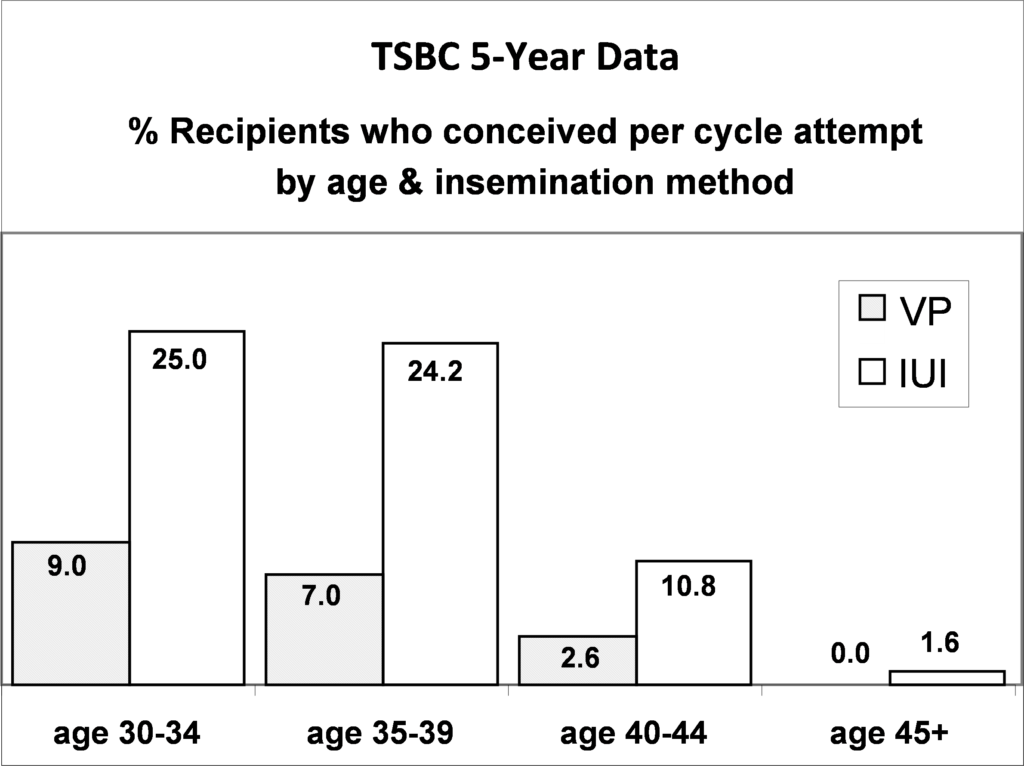As a service to our recipients, we make our conception rates available. We calculate success rates using five years of data to provide better estimates of the likelihood of conceiving. The most recent analysis is for conception attempts and outcomes from 2012-2017.
We track overall success rates and rates based on insemination method and recipient age. The latter information may be especially relevant to TSBC recipients as almost 60% are 35 years or older. We encourage anyone interested in learning more about age and fertility to read our Conception Strategies.
TSBC overall success rates
Vaginal Insemination & IUI Combined Success Rate: 18.5% per cycle
This rate of 18.5%, or almost a 1 in 5 chance in conceiving each cycle attempt, matches industry standards for conception through donor insemination. The rate is based on 5099 cycle attempts. It includes (i) all recipients regardless of their age and (ii) all insemination attempts done vaginally, intrauterine, or combined vaginal and intrauterine. Based on an older life table analysis across consecutive cycles, 80% of TSBC recipients conceive within 7 cycle attempts.
Success rate: insemination method & age
 To calculate the success rate per cycle attempt according to the recipient’s age and method of insemination, we compared the total number of conceptions resulting for each recipient age group based on their insemination method to the total number of attempts by each age group by insemination method. From this, we then calculated a percent success rate per cycle attempt for each insemination method dependent on recipient age (see Figure).
To calculate the success rate per cycle attempt according to the recipient’s age and method of insemination, we compared the total number of conceptions resulting for each recipient age group based on their insemination method to the total number of attempts by each age group by insemination method. From this, we then calculated a percent success rate per cycle attempt for each insemination method dependent on recipient age (see Figure).
Key findings:
- Vaginal inseminations work better among younger recipients.
- IUI tends to be more successful than vaginal insemination (IUIs have 3-4 times higher success rates than vaginal insemination for recipients in their mid-30s to early 40s)
- Success rate is related to a recipient’s age: As you get older, the probability of conceiving decreases. Nevertheless, IUI still results in reasonable success rates, with recipients ages 40-42 (subgroup of age 40-44) on average experiencing a 1 in 10 probability of conceiving in a given cycle attempt. For recipients age 44+ successful pregnancies using their own eggs are unlikely–IVF using eggs from a younger person (or their own eggs stored when they were younger) greatly improved chances of success.
Notes on the analysis
- Vaginal inseminations: The sample of recipients who did vaginal inseminations varied in whether they did one or two inseminations per cycle. Two inseminations were weakly associated with a better success rate.
- IUIs: Our sample included recipients who did one IUI in a cycle attempt and those who did more than one. We were unable to compare whether two IUIs was better than one, due to an unequal distribution of recipients using fertility drugs across the two groups.
- Recipients under age 30: Our sample included too few recipients to calculate a success rate. Fertility studies indicate, however, that this age group has the highest chance of conceiving in a cycle attempt.
- Recipients over age 44: In our sample, no live births were reported for this age group when they used vaginal insemination alone. Virtually all live births to recipients age 44+ are conceived using IVF and the vast majority are using eggs from someone younger (or their own frozen eggs/embryos retrieved when they were younger).
- Given that fertility is so closely tied to recipient age, anyone age 35+ should read our Conception Strategies.
Conclusions
Our results match findings from the fertility industry and are consistent with clinical research indicating that IUI tends to be more effective than vaginal insemination. Because vaginal insemination is less intrusive and easier to do at home, some may want to try this method first. But if you are age 35+ and have age-related time constraints, we urge you to consider using IUI. For those age 44+, egg donation was the most common route to a live birth outcome. Overall, based on these and early analyses, recipients under age 44 can expect to inseminate for four to eight cycles before conceiving.
